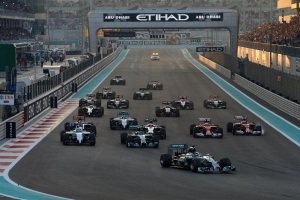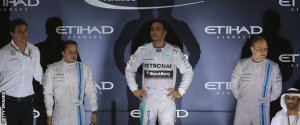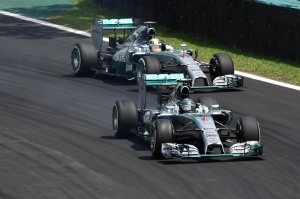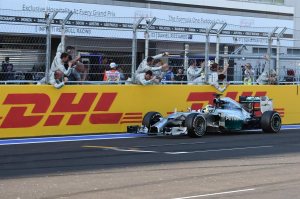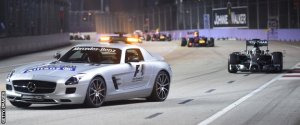After all the build up, all the anticipation and drama of the 2014 Formula 1 season came down to one race, worth double points, in Abu Dhabi. It was a straight fight between the two Mercedes team-mates Lewis Hamilton and Nico Rosberg. While Hamilton went into the race with a 17 point advantage, Rosberg had the advantage of starting on pole position.
Things were finely poised, but Hamilton knew that he only had to finish second to Rosberg to win a second world drivers’ championship. Rosberg, on the other hand, went into the race knowing that he had nothing to lose. The outcome of the title was largely out of his hands. He needed help from others or a car problem for Hamilton to take his first championship. As Rosberg frequently reminded the world, and his team-mate, in the build up to the race, the pressure was on Hamilton.
You wouldn’t have guessed it from the way the two Silver Arrows cars started the race, though. As the lights went out Hamilton took off, blasting past his team-mate to take the lead. It was the perfect getaway for Hamilton, who could watch in his mirror as Rosberg got a poor start and had to defend from Felipe Massa’s Williams going into turn 1.
As it turned out, Hamilton never looked back. He pulled out of DRS range immediately and built up a two to three-second advantage over Rosberg, which stayed stable throughout the opening stages of the race. It remained like that through the first pit stops until lap 23 of the race. It was at that point that things went from bad to worse for Rosberg.
The German appeared to lock up in the final sector of the lap, losing time to Hamilton. The gap expanded to around four seconds and if that had been the end of it Rosberg would still have been in with a shot. Sadly for the five time 2014 race winner, it only signalled the start of his troubles. Rosberg soon reported that he had lost power and his Mercedes team soon confirmed a hybrid system failure on his car.
The loss around 160hp from the failure of his ERS system was crippling for Rosberg. He started losing time hand over fist. Just a few laps later Massa blasted past him in his Williams, and he wasn’t the only one. As the laps ticked by Rosberg dropped further and further down the field, losing position after position as, despite his best efforts, cars cruised past his stricken Mercedes down the straight.
It is to Rosberg’s credit that he finished the race, despite his team suggesting that he should retire his car. In the end he finished in 14th positions, after being lapped by his team-mate. While it was a massively disappointing way to finish the season for Rosberg, it was very much delight for Hamilton.
The Briton took his second world drivers’ crown after a six-year wait since his 2008 championship win with McLaren. Hamilton survived some late pressure from Massa in the Williams, who ran a short last stint on the faster super soft tyres, to win the race by 2.5 seconds. Even without Rosberg’s troubles in Abu Dhabi, the German was never in a position to take the drivers’ championship. Had he not had his ERS failure and had somehow managed to catch and pass his team-mate – something that he hadn’t managed all season – Hamilton would still have finished in second place, which was all he needed to take the championship.
Thankfully, too, double points turned out not to be a factor in deciding the fate of the title. Hopefully this will be the first and only time this gimmick is used in Formula 1. Indeed, the only man to benefit was Valtteri Bottas, who took third place in the race behind his Williams team-mate Felipe Massa, and with it, fourth place in the drivers’ standings. It was an impressive end to the season for a resurgent Williams team, which took third place in the constructors’’ standings after finishing a lowly ninth in 2013.
2014 was, though Mercedes and Lewis Hamilton’s year. Mercedes finished as constructors’ champions with a record-breaking 16 race wins out of 19 and a record 701 world championship points. Hamilton took 11 of those race wins, more than double the number taken by his team-mate to deservedly take the world drivers’ championship by 67 points
2015 will be a season of changes, though. We now know that Sebastian Vettel will leave Red Bull Racing – the team where he won his four world titles – to join Ferrari, while Fernando Alonso will leave the Scuderia for parts unknown. Presumably the Spaniard will join McLaren with their new Honda engines, but that’s yet to be confirmed, as are the futures of current McLaren drivers Jenson Button and Kevin Magnussen.
One thing that is unlikely to change, however, is the Mercedes dominance of Formula 1. Next season already looks like it might be another shoot out between Hamilton and Rosberg, but let’s not worry about that too much now. Lewis Hamilton certainly won’t. He’s busy celebrating his second world drivers’ championship, and he’ll be going into contract negotiations with his Mercedes bosses with a spring in his step.
Abu Dhabi was billed as the duel in the desert. As it turned out, Lewis Hamilton was the jewel in the desert. It was a sparkling performance in a dazzling season from the 29-year-old.
